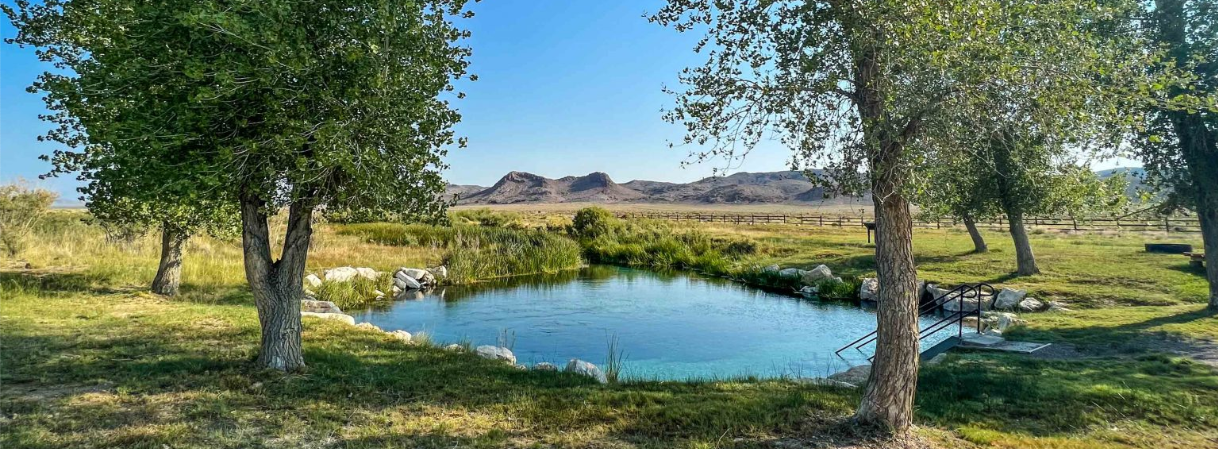
DUCKWATER SHOSHONE TRIBE
The Duckwater Shoshone Reservation is the
home of the Tsaiduka.
The Duckwater Shoshone Tribe is a quintessential indigenous nation that has had to “buy back, win back, or otherwise pursue
with great diligence and fortitude the rights and resources necessary to exist.”
Duckwater Shoshone Tribe
Historical Timeline and Background
& Water Management Capacities
16,000+ ybp Duckwater Shoshone relied on water resources throughout their Great Basin homelands.
1850+ Euroamerican colonization, westward expansion, and manifest destiny resulted taking over vast regions of fertile and water-rich areas of Goshute homelands. Goshutes were displaced, exterminated in genocidal acts, and forced onto a tiny fraction of their ancestral homelands where access to water resources was truncated in the process.
1863 On October 1, 1863, the Treaty of Peace and Friendship at Ruby Valley was signed between the United States and the Western Shoshone. In that treaty, the represented tribes neither ceded territory nor water resources therein.
1908 Supreme Court case Winters v. United States (Winters Doctrine) held that on the date the federal government created an Indian reservation along with it came an implied federal reserved water right to meet their needs and fulfil purposes of the reservation.
1940 After Duckwater Tribe purchased the 3,850-acre Florio Ranch, the Secretary of the Interior created the Duckwater Reservation pursuant to Section 5 of the Indian Reorganization Act. Subsequent legislation on June 28, 1941, December 22, 1943, and January 27, 1955, added even more acreage to the reservation.
1951 The Western Bands of the Shoshone Nations filed a petition with the Indian Claims Commission triggering a cause of action for the taking without compensation of large tracts of land Nevada and California, including lands covered by the 1863 Treaty at Ruby Valley.
2016 The Nevada Native Nations Land Act (P.L. 114-232) conveyed about 31,229 acres of BLM land to become part of the Duckwater Reservation Expansion.
2022 The Tribe developed a 175,000-acre land withdrawal proposal to be added to the Nye County Lands Bill for lands that would be conveyed to the Tribe as a reservation expansion. The lands include springs to which the Tribe holds water rights.
Water Management Priorities
DST’s main priority for on-Reservation water resources is the Irrigation Pipe Project. The current irrigation pipeline is 39 years old (original lifespan was 25 years) and is having significant problems. At least 10 miles of pipeline need to be replaced. USDA declined to fund this, and DST continues to look for funding for this project. DST’s other priorities include continuing to provide safe drinking water to reservation residents, and protecting Tribes’ water rights so they are not taken away or infringed upon and so water stays on the Reservation.
Existing Water-Related Capacity
The Duckwater Shoshone Tribe has water management capacities that serve the immediate needs of the reservation community, including both residential and agricultural uses. They have secured state-water rights of groundwater for drinking and spring/stream water for irrigation. The Natural Resources Division has two of the Tribal staff (the Division Manager and Water Operator) specialize in water matters for the Tribe and also form a small water resource program. The water program has limited funding and does not receive US Environmental Protection Agency (USEPA) grants and is not an EPA-approved Treatment of Statement. To handle the various water needs on the reservation, the Tribes also relies on an outside consultant (Certified Operator), and a water testing facility in Elko, Nevada.
Capacity-Building Needs and Interests
The Tribe has many capacity-building needs: replace irrigation water system, upgrade and modernize Reservation drinking water system, continue to ensure adequate water quality for Reservation community by water testing and treatment to meet safe drinking standards, create opportunities for additional water resources staff whose focus would be on water and utility, and exchanges with other Tribes on water resource issues, recognizing that when Tribes banded together on water issues it really made a difference.
